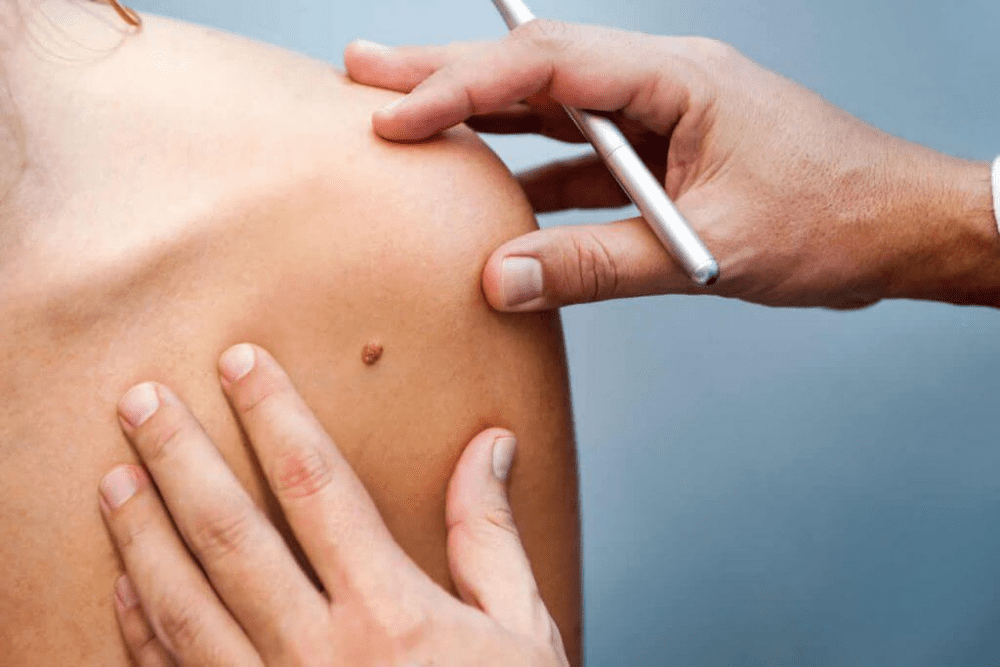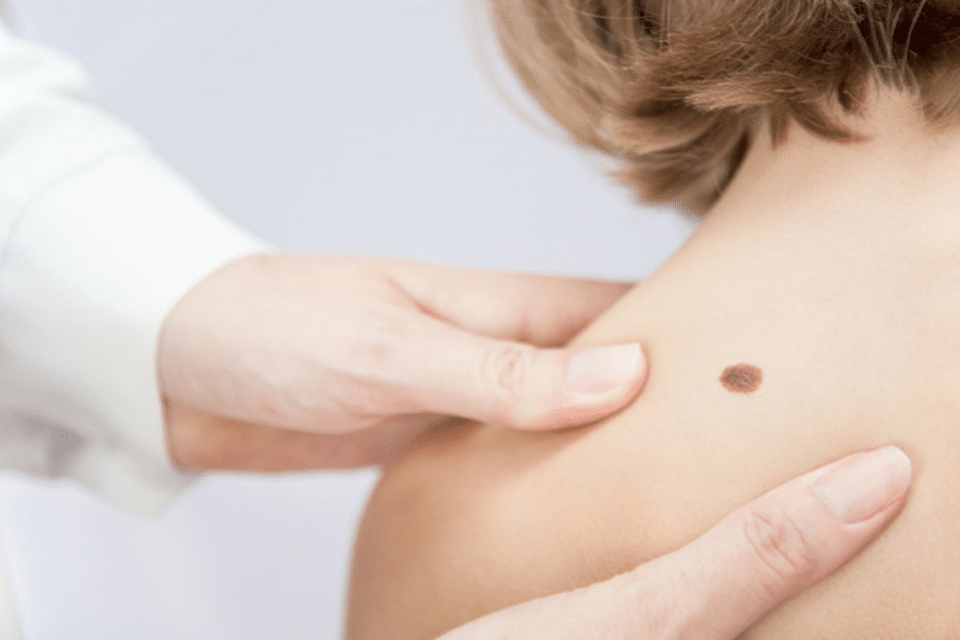Understanding Types of Moles
Benign Moles
Benign moles are common and usually harmless. They appear uniform in color and have a distinct border separating them from the surrounding skin. These moles can be flat or raised, round or oval, and generally do not change over time.
Benign moles on the body carry no cancer risk, making their removal often a cosmetic choice rather than a medical necessity for people who feel the need, especially when located on the neck. Individuals may choose to remove them for aesthetic reasons, to reduce cancer risk, or if they cause discomfort when rubbing against clothing on the neck and may return even after removal.
Dysplastic Nevi
Atypical moles, or dysplastic nevi, exhibit irregular features. They might have uneven coloring, with shades of brown and black, indicating a cancer risk, and their borders can be blurry or indistinct upon return. Unlike benign moles, these have a higher potential to develop into skin cancer, specifically melanoma.
Monitoring is crucial for people with dysplastic nevi. Any changes in size, color, or shape, indicative of a cancer risk, should prompt an immediate consultation with a dermatologist. In some cases, removal and biopsy might be recommended to ensure there are no cancerous cells present.
Congenital Moles
Congenital moles are present at birth or appear within the first year of life. Their size can vary greatly, from small spots to large patches covering significant areas of the body. While most congenital moles pose no health risk, larger ones have a slightly increased risk of developing melanoma later in life.
Families often opt for early monitoring and sometimes removal as a precautionary measure against potential cancer risks associated with larger congenital moles.
Exploring Mole Removal Methods
Surgical Excision
Surgical excision is a common method for mole removal. A doctor uses a scalpel to cut out the entire mole and some surrounding tissue. This technique ensures complete removal but might leave a scar.
It’s suitable for larger moles or those that look suspicious. The removed tissue often goes for pathology examination to check for cancer signs.
Shaving Method
Shaving is less invasive than excision. It involves slicing off the mole at skin level with a small blade. This method causes minimal discomfort and usually leaves behind a less noticeable scar.
It’s ideal for smaller, non-cancerous moles that rise above the skin. However, it might not remove all the mole cells, potentially leading to regrowth.
Laser Removal
Laser removal offers a non-surgical option. High-intensity light beams break down the mole cells. This method is quick and less painful, with minimal scarring.
It’s best for small, dark moles on the face or body. But, it may require multiple sessions to achieve complete removal.
Freezing
Freezing uses liquid nitrogen to destroy mole cells. It’s quick and effective for superficial moles but may not be suitable for deep or large ones.
This approach can cause temporary redness or blistering. Like laser treatment, it may need more than one visit.
Breaking Down Mole Removal Costs
Cost Range
The cost of mole removal on the face can vary widely. Prices range from $150 to over $1,500. This variation depends largely on the removal method and the mole’s complexity.
For simpler procedures, such as freezing flat moles, costs start at about $80. However, for multiple moles or more complex methods, prices can climb to $250 or more. The choice of technique, discussed in the previous section, significantly impacts the overall expense.
Method Variability
Each mole removal method carries its own price tag. Surgical excision, often used for larger or cancerous moles, sits at the higher end of the spectrum. It requires specialized skills and equipment.
Laser treatments and cryotherapy offer less invasive options. They tend to be more affordable but may not suit every type of mole. The location of the clinic also plays a role in determining costs. Urban centers usually charge more due to higher operational expenses.
Location Impact
Clinics in larger cities often have higher rates than those in smaller towns. This is due to increased demand and overhead costs. Patients might find it cost-effective to explore options outside their immediate area.
Insurance Coverage for Mole Removal
Cosmetic Exclusions
Cosmetic mole removal often falls outside insurance coverage. This means if you’re seeking to remove a mole for aesthetic reasons, you’ll likely bear the full cost. Insurance companies consider these procedures elective and not medically necessary.
Medical Necessity
However, when mole removal is deemed medically necessary, insurance plans, including commercial and Medicare Advantage, may cover it. Conditions such as potential skin cancer risk can make mole removal a covered expense. It’s crucial that your healthcare provider documents this need in your medical records.
Documentation plays a key role in determining insurance coverage eligibility. Without proper records indicating the medical necessity of mole removal, obtaining coverage can be challenging.
Importance of Documentation
The importance of thorough documentation cannot be overstressed. For insurance to cover the procedure, there must be clear evidence in your medical records that the mole poses a health risk or has suspicious characteristics warranting removal.
Out-of-Pocket Payment Options
Payment Plans
For those needing mole removal from the face or neck for cosmetic reasons, expect to cover the costs fully out-of-pocket. Many healthcare providers understand this can be a significant expense. They may offer payment plans. These plans allow you to spread the cost over time, making it more manageable.
Payment plans can vary in terms of length and interest charges. It is crucial to ask your provider about these details upfront. This ensures there are no surprises down the line.

Medical Credit Cards
Another option to consider is medical credit cards. These are specifically designed for healthcare expenses not covered by insurance, including cosmetic procedures like mole removal. Medical credit cards often come with promotional interest-free periods. However, it’s important to pay off the balance before this period ends to avoid high-interest charges.
Before applying, make sure you understand all the terms and conditions associated with the card.
Healthcare Provider Assistance
Lastly, don’t hesitate to discuss financial concerns with your healthcare provider. Some offices may offer their own financing solutions or know of local resources that can help reduce your out-of-pocket expenses.
They might have suggestions for flexible payment solutions or financial assistance programs available for patients undergoing procedures deemed necessary for medical reasons, even if your case does not fall under this category.
Longevity of Mole Removal Benefits
Permanent Results
Mole removal often yields permanent outcomes. Once a mole is successfully removed, it doesn’t come back. This permanence offers peace of mind, especially for those who had moles in highly visible areas like the face.
The skin’s appearance improves significantly post-procedure. Scarring is minimal with modern techniques, leaving the skin smoother and more uniform.
Health Advantages
Removing a mole can decrease cancer risk. Moles with irregular shapes or colors may pose a higher risk. After removal, the threat diminishes, but it’s crucial to continue skin checks.
The procedure also eliminates discomfort caused by moles rubbing against clothing or jewelry. This makes daily activities more comfortable.
Sun Protection
Despite the benefits, it’s vital to protect the skin from sun exposure after mole removal. The sun can damage healing skin, leading to complications or affecting cosmetic results.
Wearing sunscreen and avoiding direct sunlight help maintain the benefits of mole removal. It reduces the chance of new moles forming or existing ones changing in appearance.
Continuous Monitoring
Regular skin examinations are essential post-mole removal. They ensure no new concerns arise and that the benefits of the procedure last a lifetime.
Monitoring helps catch any changes early, maintaining healthy, beautiful skin long-term.
Addressing Mole Recurrence Concerns
Recurrence Rates
Mole recurrence after removal is rare. Yet, it’s a possibility that patients should be aware of. Studies show that less than 1% of removed moles might recur. This low percentage suggests that effective mole removal techniques are generally reliable.
Recurrence often depends on the removal method used. Surgical excision, for instance, has a lower recurrence rate compared to less invasive methods like laser removal or cryotherapy.
Dermatological Follow-ups
Regular check-ups with a dermatologist are crucial after mole removal. They help in early detection of any new growths or changes in existing moles. Patients should schedule annual visits or more frequently if advised by their dermatologist.
These follow-ups can catch potential recurrences early when they are most manageable. Dermatologists can also provide guidance on self-examination techniques for monitoring moles at home.
Early Detection Benefits
The importance of early detection cannot be overstated in managing recurrent moles effectively. When caught early, treatment options are more straightforward and less invasive.
Early intervention also reduces the risk of complications, including potential skin cancer development from abnormal moles. It underscores the value of being vigilant about skin health post-mole removal.
Final Remarks
Navigating the maze of mole removal, especially on your face, demands understanding the types, methods, and costs involved. Armed with knowledge about insurance coverages and out-of-pocket options, you’re better positioned to make informed decisions that align with your financial and health goals. The longevity of results and addressing potential mole recurrence are also crucial to ensure you’re set for long-term satisfaction. Remember, every choice you make towards enhancing your appearance is a step towards boosting your confidence and well-being.
Ready to take the next step? Don’t let uncertainty hold you back. Consult with a dermatologist to get personalized advice tailored to your needs. Embrace the journey towards a clearer, more confident you. It’s time to make an informed decision that reflects your desires and budget. Your path to mole-free skin starts now.
Frequently Asked Questions
How much does mole removal on the face cost?
Mole removal costs vary, typically ranging from $150 to $1,500, depending on the method used and whether it’s performed for cosmetic or medical reasons.
Is mole removal covered by insurance?
Insurance coverage for mole removal depends on medical necessity. If a mole is potentially cancerous or poses a health risk, insurance may cover the procedure. Cosmetic removals are usually not covered.
What are the common methods for removing moles?
Common mole removal methods include surgical excision, laser treatment, and cryotherapy. The best method depends on the mole’s size, type, and location.
How long do the benefits of mole removal last?
Mole removal is generally permanent. However, there’s a small chance of recurrence if not all cells are removed during the procedure.
Can moles reappear after being removed?
Yes, though rare, moles can reappear after removal if some cells were left behind. Regular monitoring and follow-up with your dermatologist are recommended.
What are my payment options if insurance doesn’t cover mole removal?
Out-of-pocket payment options include cash, credit cards, or medical credit lines like CareCredit. Some clinics offer payment plans.
Does removing a mole hurt?
Discomfort during mole removal is minimal due to local anesthesia. Post-procedure pain is typically manageable with over-the-counter pain relief.
